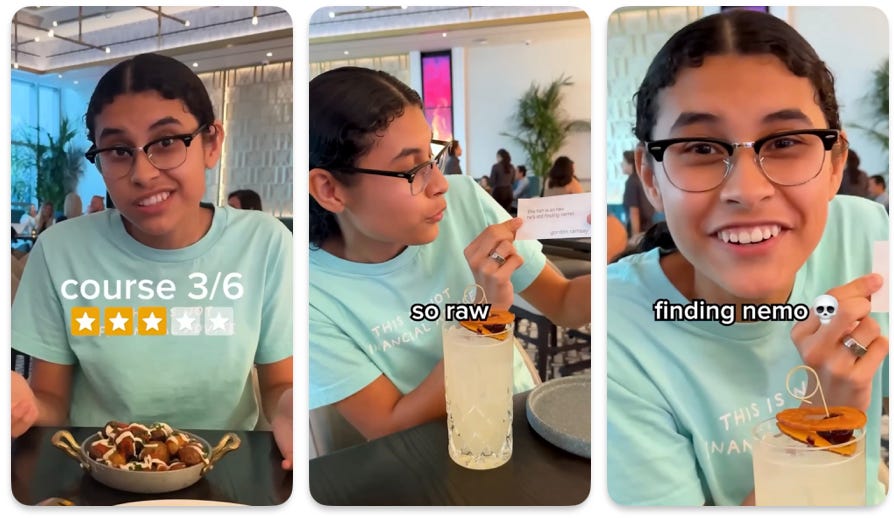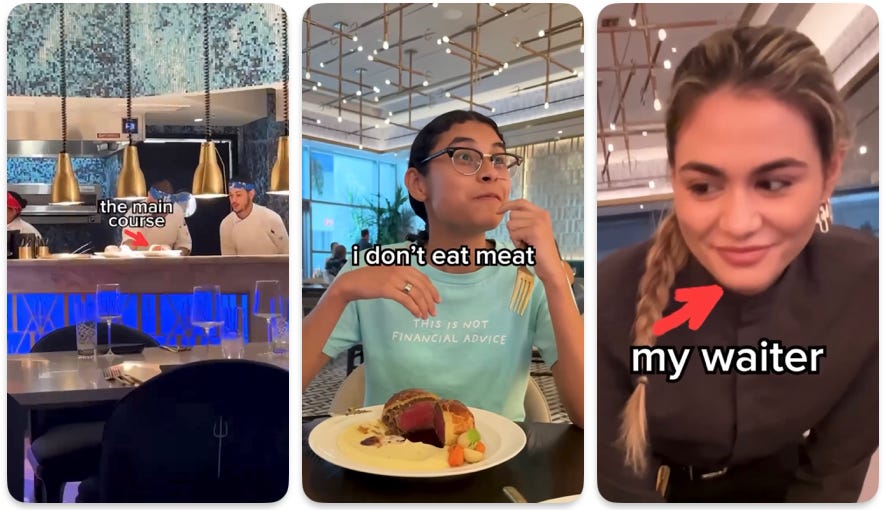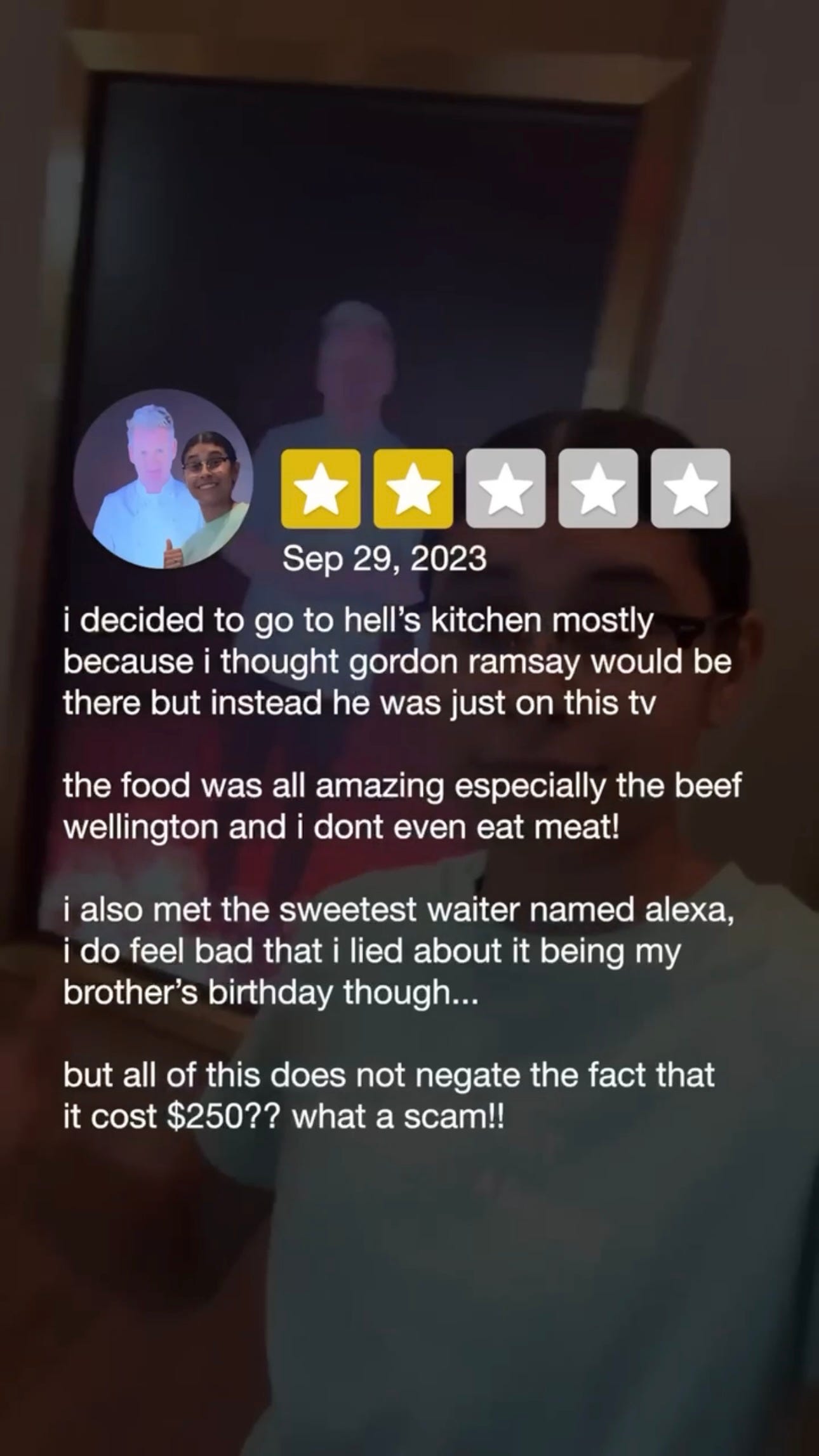how to roast Gordon Ramsay with a YouTube short 🔥🧑🍳🔥
Jenny Hoyos' goes to Hell and comes back to tattletale
YT short of the week #004
👋 Hello friend,
Generally speaking, you can divide content into two oceans:
I did: “I trimmed my nails last Tuesday, and this is what happened”.
They did: “This is how Emily Dickinson trimmed her nails every Tuesday”.
Today we are here to learn from a master in the I did category:
the almighty Jenny Hoyos.
With over a billion views under her belt, she's a top short-form storyteller, and here is how she does it.
4.7M views / 323K likes / 621 comments
🍱 let's break it down:
Story Beat 1: declare the mission
"This is the most expensive restaurant in my city, so I ordered a six-course meal for $250 to find out if it's worth it."
Jenny plants multiple questions with a clear-cut goal:
Is this restaurant worth it?
Is Gordon Ramsay overhyped?
What kind of food do they serve for that price?And the universal question:
Am I getting enough value for my money?
Story Beat 2: subvert the initial bias
Why it works:
First payoff. Jenny surprises by giving a 10/10 right away.
I expected her to be more critical of such a high-ticket meal (her channel is all about budget options).Also, Jenny does a clever thing. She narrates with a voiceover but adds sound inserts of the live footage to keep it varied.
Story Beat 3: setbacks
V.O: "Then I explored the place and literally thought I saw Gordon Ramsay himself, but it was just a TV.”
Gordon: “Idiot sandwich.”
V.O: "Then I found out my friend ate all the scallops while I was gone."
Friend: "8 out of 10.”
Why it works:
Action/consequence. Not all is glam and clam at the restaurant. Jenny goes exploring but misses out on the scallops. She hoped for Gordon, but it was just the TV.Setbacks, however small, will keep us wondering what's next.
Story Beat 4: ramp up the review
V.O: “potato bites”
Jenny: “six, sorry Gordon”
V.O: “chicken”
Jenny: “give it a seven. it's not good”
Why it works:
Multiple payoffs. Jenny delivers on the main promise: the food. We get to see the dishes and what she likes and what she doesn’t.
This is a more predictable bit to counter the unexpected ones from before.
Story Beat 5: slow down, Nemo
V.O: "Then the drinks arrived with a note from Gordon himself."
Jenny: “The fish is so raw he's still Finding Nemo."
Why it works:
Here is where Jenny over-delivers on the promise.
We came to know about the food, but she now expands to drinks.
All is game for review.
Also, it’s a funny bit praising Gordon after being disappointed with the chicken.
Story Beat 6: a little drama for dinner
V.O: “and the main course was Ramsay's classic Beef Wellington.”
Jenny: “I don’t eat meat.”
*dramatic pause* 🫢
Jenny: “It’s pretty good!”
Jenny makes it personal by telling us that she doesn’t eat meat, but she’s willing to try.
Revealing bits of your character is a great way to create tension or humor.Also, it helped to raise the stakes for the moment since it’s the signature dish of a celebrity chef.
High-octane drama right there.🎭
Story Beat 7: review the waiter
V.O: "The service was amazing as well and not just cuz my waiter subscribed."
Alexa: “I’m so glad to have you guys tonight.”
Why it works:
Not sure if Jenny did this on purpose, but she opened the short by saying “a 6-course meal”, so the addition of drinks, service, and the human component (Alexa the waitress) keeps things unexpectedly fresh.
Cheeky way to remind the viewers to subscribe as well.
Story Beat 8: dessert and sneaky deeds.
V.O: “To finish off the night, I lied about my brother's birthday to get free dessert, which tasted like heaven despite being from Hell’s Kitchen.”
Why it works:
A reminder of who she is: a budget-maximizer.
It’s sneaky but, hell, $250 for a meal is steeeeep.
I would have done the same. And let’s get real: we’ve all thought of taking a fork home when fine dining.🎩
Story Beat 9: grand verdict
Why it works:
A YT shorts lil’ trick: if you want them to rewatch, place a piece of info that sparks curiosity for just a second or less.
Finally, another subversion of what I was expecting. Jenny led us to think that she was thrilled and satisfied. But she still gave her honest opinion.
All loops closed. We good for drinks now.
“The Jenny” story recipe for printing 🖨️:
1: declare the mission. “I will do this to see if…”
2: subvert the initial bias: whatever we expect you to do, do the opposite.
3: setbacks: no matter how small, show some struggle.
4: ramp up the review: fulfill the initial promise.
5: slow down, Nemo: expand the scope of your quest.
6: main dish drama: meeting the final boss. Inject personality.
7: review the waiter: add a character, a sidequest.
8: dessert and sneaky deeds: return to the starting point, wiser.
9: grand verdict: share the transformation. Was it worth it?
Jenny excels at making small details feel like an adventure. She's a big advocate for the but/therefore technique.
You don't have to spend $250 at Hell's Kitchen to have an adventure we'd like to watch.
Buy the cheapest of something.
Try a medieval stretching technique.
Follow the advice from a fortune cookie.
If you know what your audience cares about (in Jenni's case is non-financial advice). You're golden. Do de deeds. We're here to watch. 👀
keep it simple: goal - obstacle - resolution.
And that's my time for today.
So glad you're here.
Consider sharing with a friend if you get any value from this breakdown.
See you next week
PS: I have a YouTube channel; have a look :)
Matias Ruiz-Tagle
Founder of Atomic Stories











